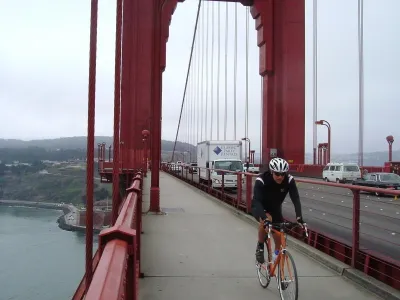The Golden Gate Bridge District is looking at ways to improve safety on the bridge's narrow, windy bike and pedestrian paths.

According to data from the Marin County Bicycle Coalition and a Golden Gate Bridge District study, "a cyclist is five times more likely to crash traversing the Golden Gate Bridge as a motorist, and 21 times more likely to be injured." This indicates the need for improved bike and pedestrian infrastructure on the famous bridge, writes Roger Rudick.
The data shows that "there were 19 times as many solo bicycle collisions as there were bicycle-pedestrian collisions," partly due to newly installed fence slats that "amplify gusts, knocking cyclists over." The Coalition "is urging cyclists to participate in an outreach program, recently launched by the Bridge District, to get feedback and more information to figure out how to reduce crashes."
"[T]he District’s study, released last year, includes some specific improvements, such as: 'install additional high visibility wind warning signage along the west sidewalk to raise awareness' and 'implement a Standard Operating Procedure to shift bicycle traffic to the east sidewalk during hazardous wind conditions.'" The MCBC's assessment "also puts partial blame on Bridge District maintenance crews that use the path as a storage area," leaving less room for bicyclists to maneuver. "We are surprised to see that the study does not make any recommendations to increase clearances for two-way bike traffic going past construction material." Streetsblog comments that "crews would never regularly store materials in a motor-vehicle lane on the bridge, certainly not without significant traffic diversions and guidance. So why is a bike path seen as a suitable place to dump stuff?"
"MCBC is asking riders of the Golden Gate Bridge to check out all their recommendations, review the District’s study, participate in the outreach program, and take the Golden Gate Bridge District poll."
FULL STORY: New Push For a Safer Golden Gate Bridge

National Parks Layoffs Will Cause Communities to Lose Billions
Thousands of essential park workers were laid off this week, just before the busy spring break season.

Retro-silient?: America’s First “Eco-burb,” The Woodlands Turns 50
A master-planned community north of Houston offers lessons on green infrastructure and resilient design, but falls short of its founder’s lofty affordability and walkability goals.

Delivering for America Plan Will Downgrade Mail Service in at Least 49.5 Percent of Zip Codes
Republican and Democrat lawmakers criticize the plan for its disproportionate negative impact on rural communities.

Test News Post 1
This is a summary

Test News Headline 46
Test for the image on the front page.

Balancing Bombs and Butterflies: How the National Guard Protects a Rare Species
The National Guard at Fort Indiantown Gap uses GIS technology and land management strategies to balance military training with conservation efforts, ensuring the survival of the rare eastern regal fritillary butterfly.
Urban Design for Planners 1: Software Tools
This six-course series explores essential urban design concepts using open source software and equips planners with the tools they need to participate fully in the urban design process.
Planning for Universal Design
Learn the tools for implementing Universal Design in planning regulations.
EMC Planning Group, Inc.
Planetizen
Planetizen
Mpact (formerly Rail~Volution)
Great Falls Development Authority, Inc.
HUDs Office of Policy Development and Research
NYU Wagner Graduate School of Public Service



























